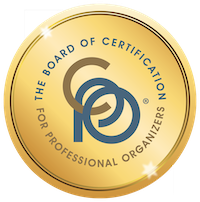Lessons learned while decluttering
I love it when I find myself in situations that plant me squarely in my clients’ shoes. This past weekend, my friend Aby Garvey, who is an amazing organizer, offered to come to my house to help me organize my office. We swap services occasionally and it’s always fun and rewarding.
While we were going through my vast collection of office supplies (oh, how I love office supplies!), I heard myself say some things that I hear my clients say with a certain amount of frequency. Here were some reasons I initially gave for not wanting to part with items:
- I’ve had it for years!
- That could come in handy some day
- I don’t use it anymore, but it did such a good job when I did use it
- I worked really hard to get that
- It was expensive
- It’s a keepsake
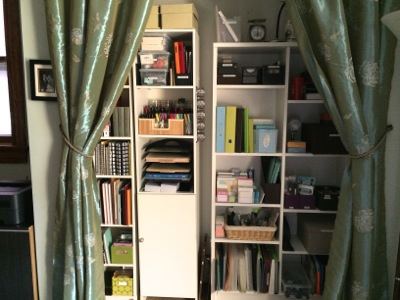
The truth is that once I got rolling, it became easier to give up items. I knew how much better everything would look there was less of it. But, as you can see from the above picture of my office-supply closet, I did manage to keep quite a bit. At least everything’s stored beautifully.
Here are a few things I learned:
- I don’t like using binders, so it’s okay to give up my copious binder accessories
- If I have a two years’ worth of a magazine I’ve never read, it’s okay to decide I’ll never read the issues-and give them away.
- People are happy to take your free magazines via a free listing on Craigslist
- It might be possible to have too many colored sharpies
- Mason jars make great pen holders
It can be hard to give up items that you’ve had for years and that you bought for a reason. But identifying those items that you’ll probably never use can free up space for stuff that you actually need. Out with the old and in with the new (or in with the clean space)!
Making your move easy(ier)
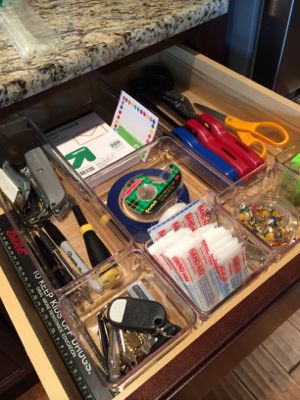
A supply drawer we created while unpacking a client
Moving is stressful. There’s pretty much no way around it. Even if an employer is paying for the move and you have the movers pack you, there are a lot of details with which to contend and it’s a hassle. Working with a professional organizer can help, but even so, the process is stressful.
I’ve recently helped several clients settle into their new homes by bringing in teams to unpack and organize their belongings. All of them were packed by the movers. Observing how the unpacking and organizing process went, I’ve identified a few ways to make the move easier:
- Start early. It’s easy to procrastinate on decluttering, packing, and making logistical arrangements. But the more time you can give yourself, the less stressful the process will be—and the more likely you are to avoid last-minute crises.
- Declutter before the move. If an employer is paying for the move, you might be inclined to delay decisions about letting go of stuff until after you see how it might fit into your new home. But believe me, by the time you’re in the unpacking phase of the move you’re going to be tired. And the fewer decisions you have to make when you unpack, the happier you’ll be. Less stuff = easier move.
- Go through the unopened boxes from the last move. If you’ve been in your home awhile and there are still unopened boxes in your storage area, don’t just move them. Open up those boxes and find out whether the items inside merit the space you’re giving them and the effort and money involved in moving them.
- Categorize before packing. If each box contains a category of items, unpacking is much more streamlined, and less frustrating. It can also make it easier to find an individual item before you’ve finished unpacking. If you don’t organize before you pack, you’ll end up with a hodge podge of items in each box, which can create headaches when you’re unpacking.
- Mark the boxes for the destination room. If the layout of your new home is different from the old one, try to mark the boxes for delivery to the appropriate room in the new home, rather than the room it came from. That way you’ll be able to stay in the room that you’re unpacking.
- Try to unpack as much as possible as soon as you move in. I’m typically a big fan of little and often, and if you need to break down unpacking into tiny chunks in order to get it done on your own, so be it. But if you can power through the unpacking process so that you get rid of boxes and get settled, the transition will be easier.
- Unpack the kitchen first. I think it’s hard to get a semblance of normalcy until your kitchen is unpacked. When you can make coffee in the morning and fix yourself a snack, life is better. Eating off of real plates rather than paper plates will make you feel like you’re home.
- Let go of perfection. Don’t get bogged down in the unpacking process trying to decide the perfect place to store items. You can always improve on it later. Just choose a location and see how it works.
- Enlist help. Unpacking a home on your own can be overwhelming. Enlist the help of friends, family or a professional organizer. In the last two unpacking jobs we did, we were able to get the entire homes unpacked in two days. It felt like a miraculous transformation—from a sea of boxes to a comfy home in two days. The clients still had tweaking to do, certainly, but they were able to get in with their daily routines.
Yes, moving is stressful. But it doesn’t have to be a nightmare. With a little planning and forethought, you can make it relatively easy.
Keyboard love
A couple of weeks ago, I bought a new computer. I’m now the happy owner of a 13-inch mid-2014 MacBook Pro with Retina Display. It replaced a 13-inch mid-2011 MacBook Pro that had become sluggish.
So far it’s going great. Apple transferred my data from my old computer to the new one. Mavericks was easy to get used to (I’d upgraded from Lion). The computer is very fast. I’ve had few, if any compatibility issues. I swear, I love my Apple products and their ease of use. (But you knew that, didn’t you?)
Since I was shelling out all that dough, I decided to add on a couple of peripherals. One is the Elgato Thunderbolt Dock ($225). I connect my computer to it via a Thunderbolt cable and into it I connect my monitor, external hard drive, and other USB devices. So when I want to unplug my computer and take it on the road, it’s just a matter of unplugging the dock and the power cable. That’s going to change the landscape of my cord control which I’ll blog about as soon as I’ve figured it out.
The other thing I bought was the Belkin YourType Wireless Bluetooth Keypad ($50) to supplement the standard Apple aluminum keyboard I use at my desk. For years, I loved my now-discontinued white plastic Apple keyboard that included a numeric keypad and a delete key (as opposed to a backspace key) that deletes the character to the right. It finally bit the dust and I’d had to satisfy myself with a keypad- and delete-key-deficient Apple keyboard, because I really didn’t want a wired keyboard. But the Belkin product, which is designed be compatible in appearance with the Mac keyboard has saved the day. Here’s a photo from the Apple website—the keypad is on the left, next to the keyboard:
It makes me very happy now, but when I was trying to install the keypad, I wanted to pull my hair out. As part of the pairing process, you’re asked to press the key to the right of the shift key. There’s no shift key, so that’s impossible. I went online, read the complaints, then tried something that was suggested. I changed the batteries. (Never mind that I’d put in fresh batteries already.) Once that was done, the little keypad worked like a dream. I mention it in case you buy one, so that you can avoid the frustration I experienced. Probably simply taking out the batteries and putting them back in would suffice.
Sometimes it’s the little things that count and this little thing has made my new computer seem all the more special.
Worth repeating: Getting started
I love this trick from Mark Forster about tricking your reactive mind into starting things you’re avoiding. I shared it first in 2008 (!) and thought it was worth repeating six years later.
Do you ever have items on your to-do list that just loom there? You know you need to do them, you think about doing them, but you just can’t get going on them?
Sometimes, you just need to get started and once you overcome the resistance and do the task, it turns out that it’s not so bad. This happens to me all the time. I build up tasks in my mind, thinking they’re going to take forever, then they take no time at all.
Certainly, this is true of many organizing tasks. But it’s also true of other things, even housecleaning.
I hate cleaning house, particularly vacuuming. And my least favorite vacuuming project is our front stairs, which have a carpeted runner. I use a small, noisy hand vac on these stairs and never want to do the job. You can imagine how awful these stairs usually look, since the carpeted runner is burgundy and our ever-shedding cat, Joe, is orange.
Anyway, Mark Forster has a great little trick for getting started on tasks you don’t want to do. In his book Do It Tomorrow, he talks about how we have a rational part of our brain and a reactive part of our brain. It’s the reactive brain that stops us from doing stuff we don’t want to do. He says that our reactive brain is unable to detect when the rational brain is lying to it. So we can calm our reactive brain by fooling it—and then we can actually get started on tasks.
Here’s how it works. I’ll use vacuuming my stairs as an example.
I’ll say to myself, “I’m not really going to vacuum the stairs now, I’m just going to get out the vacuum.” That’s enough to calm down the reactive brain. The rational brain knows that the stairs are dirty and really must be vacuumed. It knows that it takes less than 10 minutes to vacuum them and they look really nice once they’re clean. So once the reactive brain has been tricked into submission by the phrase, “I’m not going to vacuum the stairs,” the rational brain takes over and just does it.
I know it sounds a little out there, but I’ve used this trick many times. Give it a try!
This is just one of Forster’s tips for overcoming resistance. Do It Tomorrow is full of this kind of revolutionary information that can really enhance your productivity. I heartily recommend it.
Dealing with orphan socks
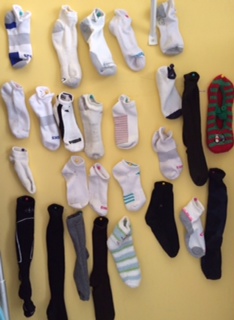
As I toured a new client’s home recently, I was struck by the clever solution she had created in her laundry room for dealing with orphan socks. She created a sock wall!
When a sock comes out of the dryer that doesn’t have a mate, she just pins it to the wall using a push pin. If the missing sock shows up in a subsequent load, she can easily identify its mate. She told me that if an orphan sock languishes for a period of time, she tosses it.
I think this is great, because it’s easy, sustainable, and very visible. I think if it were my laundry room, I might want to minimize holes in the wall (and socks) by putting up a bulletin board of some sort and using push pins with binder clips to hold the socks. But the principle is terrific!
Orphan socks aren’t a huge problem in my home because we minimize the number of different types of socks we have. My husband and I each have one type of white socks we wear with sneakers and a minimal number of dark socks. When I do come up with a sock without a mate, I just put it in the sock drawer and trust its mate will join it soon.
What about you? How do you handle orphan socks?
The dark side of my iPhone love
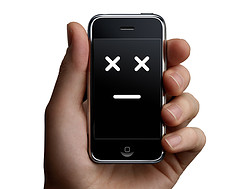
I truly love my iPhone 5S, as I’ve mentioned here repeatedly. (And before the 5S, I loved my 4S with equal fervor.) But on Friday, I came to know the flip side of that love: Dependence and betrayal.
I was leading a team at a client’s house, trying to keep my eye on the clock. Since I got my Fitbit Flex I depend on my trusty phone to tell me the time. I consulted it at 3:42. Then, at about 4, I pulled it out of my pocket to check the time and the phone didn’t turn on. I was puzzled as to why the it would have run out of battery power since I’d barely used it all day. I borrowed a charging cable from my client and plugged it in. No response from my phone. I left it plugged in for a couple of hours (it was a long day) and it remained dead.
The moment I realized I did not have use of my phone until I could take it to the Apple Store (the first available appointment was in 24 hours), I felt a little sick. And a little panicky. And sort of betrayed. It made me realize how much I’ve come to depend on this little device.
As I’ve gleefully mentioned before, I depend upon my phone for the following:
- Phone calls (I have no landline)
- Texting
- Access to email when I’m out and about
- Access to my calendar
- Access to Evernote for my various notes about life
- Access to the web to look stuff up
- Camera
- Reminders
- Mileage tracker
- Calculator (I needed to calculate what I owed my team members and how much my client owed me)
- Staying in touch with my husband (I phoned my husband from my client’s phone so that he wouldn’t worry when he couldn’t reach me)
That’s a whole lot of stuff to suddenly lose access to.
I did feel good that even if I my phone was permanently dead, at least most of my phone’s contents were automatically backed up to iCloud. And I kicked myself for not having sent a Milebug report to myself very recently.
There’s a happy ending here. On Saturday morning, I decided to try my phone again and it came on. Everything seems to be working fine. I rescheduled my Genius Bar appointment to Tuesday, to avoid the weekend crowds. I’m going to have them run diagnostics to make sure the phone is okay. (And I sent myself a Milebug report.)
The whole episode got me thinking: Should I try to reduce my dependency on my phone? Should I have a backup plan in place in the event it dies again? I haven’t come to any conclusions. (I’m just so happy that it’s back.)
Do you depend on your phone as much as I do? Do you have a plan in place in the event you were to lose your phone or it were to die suddenly?
Photo by Nathan Borror via Flickr. Used under Creative Commons License
Worth repeating: On being an order catalyst
I published this post nearly two years ago. I’m still struck by the power a person can play in helping move forward by sitting in virtual silence.
One of the roles I frequently fill for my clients is what I like to call an “order catalyst.” They often find that they simply can’t do organizing tasks on their own. But when I’m there, sitting quietly, they can go about getting their organizing work accomplished, be it decluttering, sorting, or going through their task list.
I’m not the only one who does this. It’s something that many professional organizers (or even friends) do. In the study of chronic disorganization, the term used for this is body doubling. I have to admit I’m not a huge fan of that term. I don’t think it is very descriptive and I don’t think it conveys the real benefit of the work. That’s why I coined the term order catalyst.
It looks like an easy job. I’m with the client, sitting companionably, sometimes handing her items or working on a small task that will help achieve her goals. If an outside person were to come in, he or she might wonder how I was earning my fee.
But it’s not as easy as it looks. Once I recognize that this will be the purpose of the session (it’s rare that we schedule one of these sessions in advance), I must refrain from offering unsolicited advice. I resist the temptation to chat to fill the silence. I have to sit still, staying in one place (that alone is hard for certain people), so I’m not a distraction.
And I also have to turn off my inner critic who worries that the client might think I’m not doing anything or she’s not getting her money’s worth. I know that I’m offering a truly valuable service; I just sometimes worry that the client won’t recognize it. It’s not a particularly reasonable worry. The client happily hands over payment, sometimes adding, “I couldn’t do it without you.”
I love serving as an order catalyst. Sometimes it feels a little like I have a super power.
If you have difficulty getting organizing tasks done, despite your best intentions, you might consider enlisting the aid of an order catalyst. Hire a professional organizer. Or if that isn’t feasible, enlist the aid of a supportive, calm friend. Perhaps you’ll be able to return the favor. It can be amazingly powerful!
Search
Recent Posts
- Budgeting and decluttering: It's all about priorities
- Today's truth bomb
- Worth repeating: Labels in the refrigerator
- The meat of my Bullet Journal
- Worth repeating (again): Getting past "I might need it some day"
- Furthering your goals one tiny step at a time
- Repeating spreads in my Bullet Journal
Tags
Links
- Organize Your Family History
- Ravelry
- Peace of Mind Spending
- National Association of Productivity and Organizing Professionals
- NAPO St. Louis
- Getting to Good Enough podcast
- Institute for Challenging Disorganization
- Are you interested in becoming a professional organizer?
- Shannon Wilkinson, life coach






